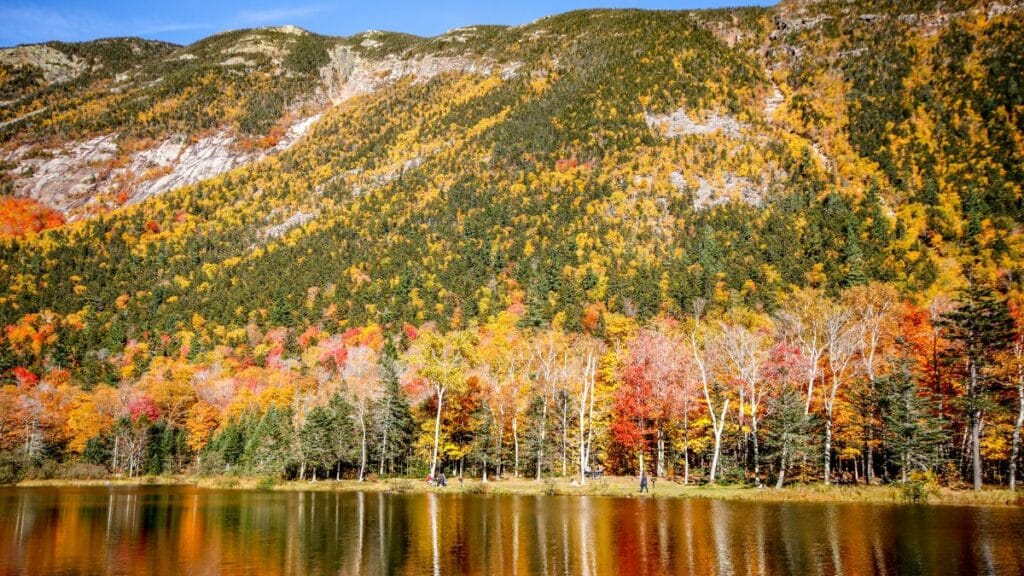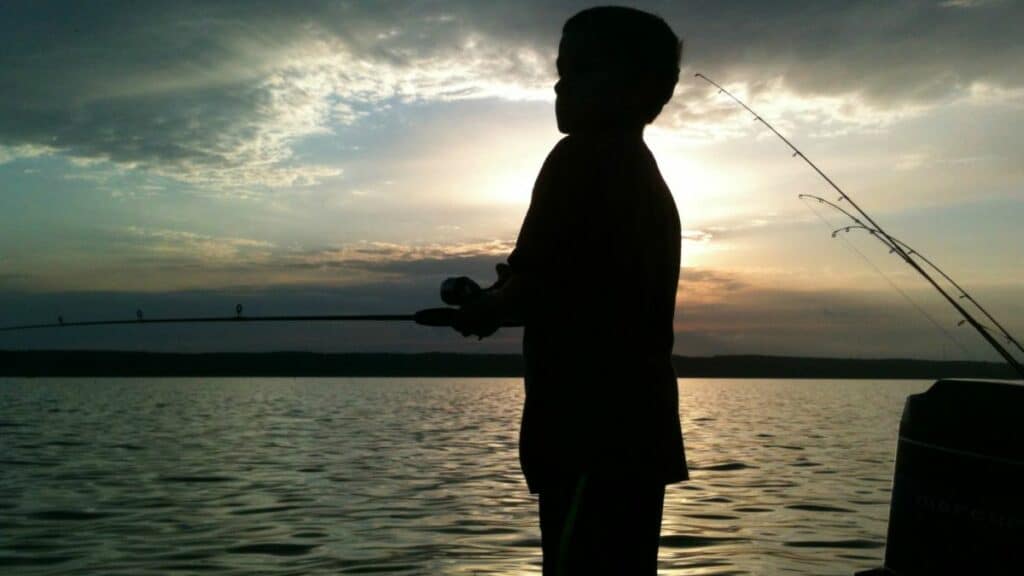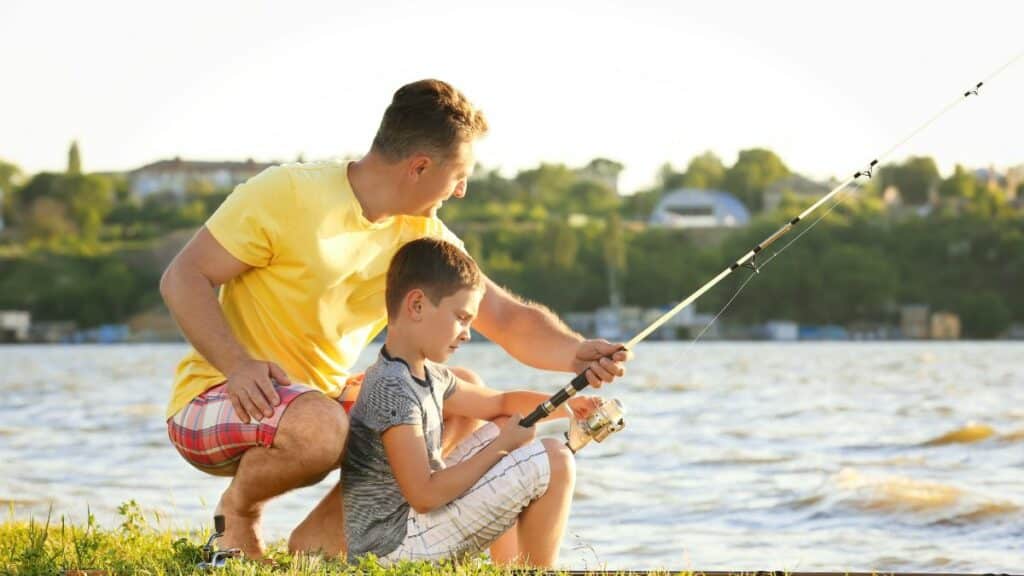New Hampshire offers a plethora of shore fishing opportunities that cater to anglers of all skill levels. Surrounded by scenic landscapes, you can enjoy fishing in diverse freshwater environments. From the extensive 44,000-acre Lake Winnipesaukee to the serene shores of the Hampton Beach State Park, your fishing adventures are complemented by the prospect of catching a range of fish such as landlocked salmon, lake trout, and smallmouth bass. The state’s abundant water bodies, including both lakes and rivers, provide a rich fishery that continues to attract fishing enthusiasts annually. You’ll find that the state’s rivers, like the Salmon Falls and Merrimack Rivers, provide fruitful grounds for shad and crappie, respectively. For those in pursuit of striped bass, the coast near Portsmouth offers several spots, including Rye Harbor and the mouth of the Piscataqua River, where you can cast your line with the chance of a rewarding catch.
Lake Winnipesaukee Shoreline

When you arrive at Lake Winnipesaukee, you’ll find a shoreline that offers a diverse range of fishing spots suited for various angling preferences. The northern end of the lake is known for warming up quickly, making it a hospitable environment for bass fishing. To locate these areas, focus on the section of the lake near Moultonborough and Center Harbor.
The shore fishing experience on Lake Winnipesaukee can be rewarding year-round, but landlocked salmon is a particular highlight. You’ll have the best chance of catching them near the shore in the spring (April and May) and fall (September and October). Using surface lures or trolling with spoons and plugs is recommended for these fish.
For bait fishing from the shore, live shiners or worms with a slip bobber can be effective. Here’s a quick guide to what you might need:
- Bait: Shiners, worms, or smelt
- Method: Slip bobber fishing
- Target species: Bass and landlocked salmon (seasonally)
Depth is a crucial factor to consider while fishing from the shore. It can vary depending on the species you’re targeting, but as a general rule, start by setting your rigs to fish in shallower waters and adjust based on the activity you observe.
Squam Lake
Squam Lake, nestled in New Hampshire, presents itself as an exceptional shore fishing location. Your experience at this serene lake affords you the chance to hook various fish such as smallmouth and largemouth bass, as well as trout and salmon.
Where to Fish:
- Squam Boat Livery Boat Ramp: Located at 853 US Route 3, Holderness, this is a starting point for your fishing expedition with accessible ramp facilities.
- Harilla Landing Boat Ramp: Found along Route 62 in Center Harbor, providing another convenient access to the lake.
Fishing License:
Before you cast your line, ensure you have a valid New Hampshire Fishing License, which is a legal requirement for fishing in Squam Lake.
Fish Species:
- Smallmouth Bass
- Largemouth Bass
- Trout
- Salmon
To increase your chances of success, local bait shops around Squam Lake can be consulted for tips on the best baits and techniques for the current season. As the location remains largely unspoiled, adhering to local regulations and practicing catch and release contribute to preserving the lake’s natural beauty and biodiversity.
Camping options in proximity to Squam Lake augment your fishing trip with the beauty and tranquility of the region. Whether you’re planning a day trip or an extended stay, Squam Lake is a prime spot for your shore fishing activities in New Hampshire.
Pawtuckaway State Park
Pawtuckaway State Park offers a serene and picturesque setting for shore fishing in New Hampshire. Nestled within the park’s boundaries, Pawtuckaway Lake presents an excellent opportunity for you to cast your line. Known for its diverse fish population, the lake is especially conducive to largemouth bass fishing.
Key Fishing Information:
- Target Species: Primarily largemouth bass, with potential catches of smallmouth bass.
- Regulations: Lead sinkers and jigs are prohibited to protect local wildlife. Always check the most current state fishing regulations before your trip.
Here’s what you need to know for your fishing adventure:
- Access Points: Multiple locations along the lake’s edge are accessible for shore fishing, providing various environments, from shallow bays to rocky shores.
- Facilities: The state park has amenities such as parking, picnic areas, and restrooms to ensure a comfortable fishing experience.
- Fishing Season: The park follows New Hampshire’s fishing seasons and regulations. Typically, prime fishing times are during the spring and fall, aligning with the bass’s active feeding periods.
Park Amenities:
| Facility | Availability |
|---|---|
| Beach | Seasonal |
| Camping | Available |
| Hiking Trails | Open |
| Boat Launch | Provided |
Your fishing experience at Pawtuckaway State Park is complemented by its other natural attractions. The surrounding area features the Pawtuckaway Mountains and varied wildlife, enhancing your visit with the chance to appreciate New Hampshire’s natural beauty as you fish. Remember to respect the environment and practice catch and release when appropriate to preserve the ecosystem for future anglers.
Merrimack River
The Merrimack River offers a variety of fishing opportunities for enthusiastic anglers in New Hampshire. Largemouth Bass is a prominent species available for you to catch in this mostly urban fishery. Besides bass, the river is home to various warmwater game species that provide an engaging fishing experience.
An accessible spot for shore fishing on the Merrimack River is Arms Park. Here, you can find a comfortable place to cast your line. Similarly, the Amoskeag Bridge area is known for being a hotspot. Don’t overlook Moore’s Falls Conservation Area and Taylor Falls Bridge as these locations are favorable for their river access and potential catches.
When planning your fishing day, consider the following popular sites along the Merrimack River:
- Greely Park
- Route 111 bridges
Your choice of bait and technique can make a difference. Live bait such as worms and minnows often yield good results, but lures designed for bass can be just as effective.
Great Bay Wildlife Refuge

When searching for prime shore fishing spots in New Hampshire, Great Bay National Wildlife Refuge should be at the top of your list. Situated along the eastern shore of Great Bay in the town of Newington, this refuge was established in 1992 to protect over 1,000 acres of land. Your experience here will be rich with opportunities to encounter a variety of migratory birds and diverse wildlife.
Key Features:
- Protected Area: Over 1,000 acres along the seacoast dedicated to wildlife conservation.
- Accessibility: Trails available for recreational activities, including fishing.
- Marine Life: Abundant fish, shellfish, and waterfowl populations.
Fishing Notes:
- Regulations: Follow NH Fish & Game regulations; ensure you have the proper licensing.
- Species: The estuary is teeming with fish, providing you fertile grounds for fishing.
- Culture: Fishing is woven into the local heritage, making it a respected pastime.
While fishing, you’ll appreciate the tranquility this hidden gem offers. It’s not just a fishing destination; it’s a chance to immerse yourself in nature. The estuary is part of the Great Bay National Estuarine Research Reserve system, offering you a unique ecosystem to explore. You are encouraged to enjoy the natural beauty while respecting the habitat that supports both the resident and migratory species that call this place home.
Mascoma Lake

Located in western New Hampshire, Mascoma Lake is a prime destination for shore fishing. Nestled between Enfield and Lebanon, the lake spans approximately 1,165 acres, offering ample space for you to find your perfect fishing spot.
When you visit Mascoma Lake, you can expect to find a diverse range of fish species. Here’s a list of the common catches:
- Largemouth Bass
- Smallmouth Bass
- Northern Pike
- Chain Pickerel
- Yellow Perch
The lake’s southeast to northwest orientation, along with its various coves, provides a good mix of conditions for different fishing preferences. To enhance your fishing experience, pay attention to the following tips:
| Tips | Description |
|---|---|
| Bait Selection | Natural baits work well, but you should also consider local tips for effective lures. |
| Seasonal Patterns | Fish behavior changes with the seasons; early mornings or just before dusk are often productive times. |
| Local Regulations | Always check for the latest guidelines to ensure you’re complying with NH fishery laws. |
For updated information, you should consult with local resources prior to your fishing trip to make the most of your experience. Enthusiasts like you share updates, so looking into recent fishing reports can be particularly helpful.
Island Pond

When targeting largemouth bass at Island Pond, you’re in for some action. Largemouth bass, often reaching weights of 4 and 5 pounds, are known to populate this area, promising a rewarding experience for those who cast their lines here. The bass are not the only draw; smallmouth bass and pickerel also offer plenty of opportunities for anglers looking to hook into a variety of sportfish.
Here’s a snapshot of what you can expect at Island Pond:
- Fish Species:
- Largemouth Bass
- Smallmouth Bass
- Pickerel
During winter, the pond transforms into a hotspot for ice fishing, with all species mentioned being active and can be caught using tip-ups.
For boat-based anglers, there is a town launch available, suitable for small boats. Access to this pond is fairly straightforward, making it a suitable location for anglers of all levels. When you head out, be sure to check local regulations and any recent fishing reports to maximize your chances for a successful outing.
Oyster River
The Oyster River in New Hampshire offers you promising shore fishing opportunities. Centrally located near Durham, this river becomes a hotspot for anglers aiming to catch striped bass, especially during the migrations in spring and fall.
Accessibility:
- Parking: Available spots near fishing locations.
- Boat Launch: Canoe and kayak launch options are accessible to fish near the docks.
- Fishing Access: Reachable shorelines offer convenient spots from Route 286.
Fish Species:
- Striped Bass: Main target with favorable conditions during migrations.
- Other Species: May include resident freshwater fish.
When fishing the Oyster River, be mindful of local regulations and catch limits. Seasonal changes can affect fish patterns, so plan your visits accordingly. For your gear, consider using herring imitations, as they tend to attract striped bass effectively.
Local Tips:
- Best Times: Aim for early morning or late evening during the migration seasons.
- Gear Advice: 7- to 10-inch herring imitation lures are popular among successful anglers.
Before heading out, check with local sources for the latest fishing reports and any advisories. Whether you’re kayaking to cast your line or standing by the shore, the Oyster River is a serene spot to connect with nature and enjoy a rewarding fishing day.
Ossipee Lake
When you’re looking to shore fish in New Hampshire, Ossipee Lake should be at the top of your list. The lake spans over 3,000 acres, nestled within Carroll County and surrounded by the towns of Ossipee, Freedom, and Effingham.
Available Fish Species
- Bass: Largemouth and smallmouth bass are prevalent.
- Trout: Find both rainbow and lake trout.
For your fishing license, contact the Lakefront Landing Marina at 603-539-4245, or visit the New Hampshire Fish and Game Department website.
Access Points for Shore Fishing
- Lakefront Landing Marina: 85 Pequawket Trail, Center Ossipee, NH 03814
- Public Boat Launches: Ideal for fishing access with parking nearby.
To maximize your fishing trip, consider the local camping options to enjoy a full weekend of angling and relaxation.
Local Facilities
- Bait & Tackle: Purchase supplies at nearby shops.
- Picnic Areas: Enjoy a meal with scenic lake views.
Please consult local resources or the New Hampshire fishing report before you set out, to get the latest on conditions and fish activity. The lake’s diverse fish population makes it suitable for all skill levels.
Popular Fish Species and Habitats
New Hampshire offers a rich tapestry of habitats that support a diverse range of fish species. Your fishing experience can be significantly enhanced by understanding where to find these species and what conditions they thrive in.
Cold Water Species: Trout and Salmon
Trout: You’ll commonly find Brook Trout, Brown Trout, and Rainbow Trout in New Hampshire’s rivers and streams. Some favored habitats are the upper Androscoggin River and designated trout ponds like Back Lake and Echo Lake.
- Brook Trout: Prefers clear, cold, and well-oxygenated water.
- Brown Trout: Often found in slightly warmer waters with good structure.
- Rainbow Trout: Thrives in habitats similar to Brook Trout but can also adapt to pond environments.
- Salmon: Lake Winnipesaukee is renowned for its Landlocked Salmon, especially during the spring when they’re near the surface. Your best chance to catch them is in areas with cooler, deep, and oxygen-rich waters.
Warm Water Residents: Bass and Panfish
Bass: Largemouth and Smallmouth Bass are abundant in New Hampshire.
- Largemouth Bass: Prefers warmer, stiller waters with plenty of coverage, such as weedy areas in lakes and slow-moving rivers.
- Smallmouth Bass: Opt for cooler, clearer waters with rocky or sandy substrates. Places like Lake Winnipesaukee and Squam Lake are hotspots.
-
Panfish: Species like Black Crappie and Chain Pickerel are readily caught in many lakes and rivers. The Connecticut River (from Lancaster south) is known for Black Crappie, while Chain Pickerel can be found in most warm water lakes.
Estuarine and Oceanic Visitors: Striped Bass and Bluefish
- Striped Bass: These migratory fish are often targeted in estuarine areas where fresh and saltwater mix. The Piscataqua River can be a great spot for finding them during their seasonal runs.
- Bluefish: While less common, Bluefish visit New Hampshire’s coastal waters in summer. They are aggressive feeders and can be found in similar areas to Striped Bass.
Techniques for Shore Fishing Success
To increase your odds of a successful catch while shore fishing in New Hampshire, you’ll want to refine your casting methods and choose the right bait or lure for the local fish species.

Casting and Retrieval Tips
To optimize your casting technique, focus on accuracy and distance. Be aware of wind direction and how it affects your cast. When using a spinning reel, practice casting with a smooth, fluid motion to reach the desired spot without causing too much disturbance. For retrieval, a steady and slow motion often entices fish, as it mimics the movement of their natural prey. If you’re fishing from a kayak, you have the advantage of quietly approaching fishing spots that are difficult to reach from the shore.
- Windward Side: Cast into the wind for a more natural bait movement.
- Leeward Side: Cast with the wind to achieve greater distances.
Bait and Lure Selection
Selecting the right bait or lure is critical for attracting the types of fish you’re targeting. Live bait such as worms and minnows can be very effective, especially for species like bass and trout. If you prefer lures, consider the behavior of the fish you’re after: use surface lures for species that feed on top, and jigs or deep-diving lures for bottom feeders. In areas like Lake Winnipesaukee, where landlocked salmon and lake trout are common, spoons and spinners can be quite successful.
- Live Bait: Ideal for a broad range of fish.
- Worms: Excellent for trout and bass.
- Minnows: Attract larger predators such as northern pike.
- Lures:
- Surface lures: Best for fish that prey near the surface.
- Deep–diving lures: Effective for fish that stay close to the lakebed.
Meet Nic Armitage, a devoted outdoors enthusiast with an insatiable love for fishing, boating, and a wide range of adventurous activities. His passion for the great outdoors knows no bounds. Nic is your trusted guide into the world of nature, sharing his experiences and expertise on the Shaman Mountain Sports and Outdoors Blog.





